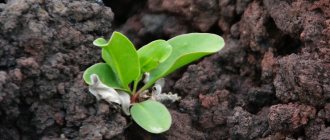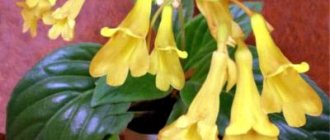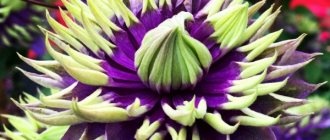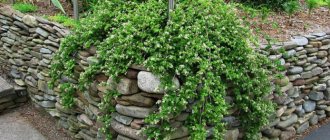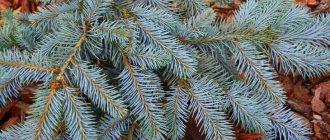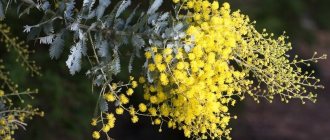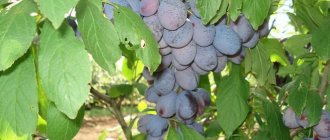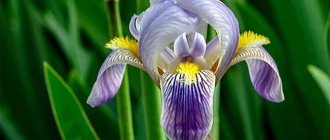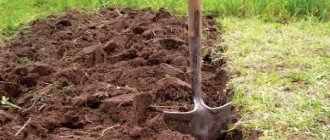Western thuja Reingold: description of the variety
Thuja Reingold: photo of the variety
This variety is very decorative. The variety was created for decorating territories, garden plots, and cities. Thuja grows in the form of a shrub; by the age of ten, the bush reaches a height of 1.2 meters. Over the course of a year, the plant grows 6 cm.
The crown is thickened, in the shape of a circle or ball, and forms perfectly. Growth ends at 35-40 years. The tree can reach a height of up to 2-3 meters.
Character traits
- The shrub has a large number of shortened branches, medium in thickness. The lower and upper branches are identical in length. The bark is dark burgundy, with a brown tint also creeping in.
- The top of young shoots has needles in the form of needles; next year the needles take the form of scales. The needles are light yellow in color with a pink tint. In the middle of the summer season, the color changes to deep orange. In the autumn season, the needles turn brown.
- The needles are densely located, tightly adjacent to the stems. Thuja Reingold is decorative because the crown is colored unevenly: the bottom is green, the top is orange.
- Cones are formed annually on the thuja, in small numbers, dark gray in color, 10 cm long. Tightly adjacent scales form cones. The seeds are brown in color, small, and contain narrow lionfish of a light beige color.
- The roots are mixed, intertwined, the roots deepen 50 cm in the center.
- The variety is resistant to gusts of wind and drafts. The plant is tolerant of environmental gases and smoke. All exotic colors are fully shown in an area where there is no shading.
- In an open space during a drought, the needles are not burned by the sun and do not dry out.
- Once every 3 years the crown is renewed, the top falls off, and in this place the bush forms replacement shoots.
Description
This variety:
- has a height of about 3 m;
- slow growing;
- perennial (about 200 years);
- considered evergreen.
The leaves are bright yellow and turn bronze in winter. During fruiting, the branches are strewn with rounded brown cones approximately 0.7 cm in diameter.
This species is well suited for growing in containers or pots placed on a terrace or gazebo. They can tolerate severe frosts down to -35-39°.
Thuja western Reingold in garden design
This type is the most decorative type, which is used in decorating garden and home areas. Due to the coloring of the crown, the shrub contrasts perfectly with any low-height flowering plants and conifers.
A small increase in height over the year, on the contrary, is for the better. The plant remains in the given shape for a long time; constant pruning is not required.
Reproduction methods
The variety is propagated by vegetative and generative methods. The plant's adaptation to new conditions is excellent. This does not depend in any way on the method of reproduction. Planting seeds takes longer than planting petioles.
The grains of the variety fully inherit the characteristic features of the mother. The collection of planting material is carried out in the last days of October, sowing occurs immediately in a container or greenhouse. The container must be left on the premises and covered.
The seeds will undergo stratification naturally over the winter, and seedlings will sprout in the spring. In the spring and summer seasons, seedlings are watered; as weather conditions become established, the shelter is removed.
Next year, in June-July, seedlings are picked in individual containers. A year later, the thuja is planted for permanent residence. From the moment the grains are sown until they are planted in the ground, 3 years pass, no less.
The vegetative method of propagation is the most effective. An interval of 2 years is maintained between the preparation of planting material and planting. The petioles are cut in the second month of summer from last year's shoots.
The middle part of 25-30 cm in length is selected. Placed in soil filled with nutrients. For the winter season, seedlings are provided with shelter. The following year watering is carried out. By the autumn season it will be noticeable which petioles have taken root. In the spring, plants are planted in the ground.
Reproduction can also be done by layering . This is a less effective method and is not used as often. Rooting of the cuttings occurs in 60% of cases, but not all juveniles can survive the winter, even if they are perfectly prepared for the frosty season.
To obtain material for planting, you need to bend the lower branch to the ground and dig it in, and always water it. The soil must not be allowed to dry out. The work is carried out in the spring, and next year you can see how many seedlings have emerged. They must be cut and immediately planted in a permanent place.
Breeding
The process itself is not very complicated; it is important to follow all the rules and steps correctly and accurately. In this case, you will be able to grow a healthy, beautiful bush. Let's consider 2 ways of breeding this plant.
By sowing seeds
It is worth noting that this planting method does not guarantee the preservation of varietal characteristics. The process itself takes a lot of time. For this growing method, you will need to purchase seeds of the required variety. They can also be obtained from woody cones from September to December. After receiving the seeds, you will need to prepare a small pot filled with soil. The soil must contain peat and humus.
Before sowing, the seeds are kept in any water-absorbing material for 24 hours. The material should be damp throughout the entire time, but should not float in water. After time, the seeds are planted shallow in the soil and sprinkled with earth or sawdust. Watering is done as the soil dries. These plants require diffused lighting. In the spring, after the ground has completely warmed up, the sprouts are transplanted outside.
There is another way to germinate seeds, in which the success rate is higher. In this case, the obtained or purchased seeds are stored in a cool place until the snow completely covers the entire soil. The seeds need to be buried in a snowdrift and left there until spring. In the first days of March, the seed is planted in the soil on the site, maintaining a distance of at least 10 cm. Until the age of 3, the sprouts must be watered abundantly until they become stronger and reach a height of 50 cm. In the 4th year, the plant is transplanted to a permanent place dislocations.
Cuttings
This method will help preserve all varietal characteristics. You need to choose good cuttings: they should not be very young or old. The cuttings should be strong and mature, about 10–20 cm long. Mature branches (2–3 years) may be suitable.
At the beginning of summer, you need to separate a branch of 25–40 cm from the main bush, keeping the “heel”. The prepared cutting from below must be cleared of needles and small branches, and then immediately immersed in a vessel with a growth stimulator for 12 hours. It is advisable to plant in a container with light, loose soil, which should include:
The cuttings are deepened into the ground by about 3–4 cm at an angle of 60°, covered with film and sprayed from time to time. When the sprouts take root, the film can be removed. In autumn they are transplanted into open ground.
For the winter, cover with fallen leaves, sawdust, spruce branches, and in case of bitter frosts, film or other material.
Thuja Reingold: planting and caring for the variety
If you are planning to plant your own prepared planting material, then inspect the root system. Remove the damaged parts, place the seedlings in a solution of potassium permanganate, leave for 6 hours. Next, place the plants for 6 hours in a solution of a drug to stimulate growth, for example, in “Kornevin”.
Seedlings bred by the generative method are taken out of the container along with the soil clod, disinfected, and a drug is used to stimulate growth. A plant purchased from a nursery does not need to be treated to protect it from fungus. It is recommended to choose three-year-old seedlings with a closed root system.
Planting dates
This variety is not afraid of frost, has tolerance to low temperature conditions down to -38 degrees and resistance to repeated frosts down to -7 degrees. These figures are taken for an adult thuja.
Young plants have less resistance. If successful rooting does not occur before frost time arrives, there is a risk that the plant will die. For this reason, there is no need to plant seedlings in autumn in temperate latitudes.
Thuja bushes are planted in the ground only in the spring. But first, wait until the soil warms up to +6 degrees. For the center of Russia, the time for planting is the first or 15th days of May.
In the southern regions, the variety takes root successfully after planting in the fall, if planting is carried out in the first days of September. If you plant plants in the spring, it is better to do this in the first or middle days of April.
How to choose a site for planting and prepare the soil
The variety is valuable for its decorative compacted crown. In order for the needles to have a rich color and active growth, the plant requires ultraviolet light. In a shaded area, the color will be dull and the crown will be sparse. That is, the place for planting thuja should be open and well lit.
The plant likes to grow on soils saturated with nutrients, breathable, lightweight, neutral or slightly acidic soils. The best soil is loam. It is important that groundwater does not lie close to the surface soil layer.
If the territory is located in a swamp, then the thuja is planted in an elevated place in the south, east or west.
Before planting, you need to dig up the place and add organic fertilizers. If necessary, neutralize the acidity of the soil with lime or dolomite flour. It is necessary to prepare filled fertile soil in advance.
It includes: sand, peat, compost fertilizer, turf.
Mix the components in the same ratio. Also, for 10 kg of soil mixture you need to add urea, 200 grams, superphosphate, 100 grams. How to plant thuja western Rheingold:
- The pit for planting is prepared 24 hours in advance. The size of the hole depends on the size of the root system. If the root system is closed, then the hole should be as wide as a lump of earth, and 70 cm deep. If the root is open, then the hole should be 15 cm wider, approximately 50x50 cm.
- A 20 cm layer of drainage system is laid at the bottom of the pit, which consists of large gravel at the bottom and small crushed stone at the top.
- The soil mixture is divided into 2 parts, one part needs to be poured into the hole.
- Next, you need to place the seedling in the central part of the recess.
- Then fill the hole with the remaining soil mixture and compact it to avoid voids.
- Then you should completely fill the hole with the remaining soil.
- Next, water and mulch.
The root collar should remain at the same height as the surface layer of soil. It is forbidden to deepen the neck or lift it above the ground. It depends on this whether the plant will take root in a new place.
Landing
Thuja "Rheingold" is recommended for gardeners who already have experience in growing coniferous plants. This variety has many features that need to be taken into account so that the shrub adapts normally to a new place and grows fully. Failure to comply with planting technology leads to the fact that the thuja “Rheingold” grows very slowly, which is why it cannot perform a decorative function.
Recommended timing
Thuja "Rheingold" is planted from mid-April to early May, provided there is no frost and heavy rainfall. At this time, seedlings adapt better and faster to environmental factors. In summer and autumn, it is recommended to plant thuja only if it is placed in a container and not in open ground.
When choosing the timing, you should also take into account the origin of the planting material. Seedlings imported from Germany or Poland are less resistant to Russian winters. Therefore, they should be planted in the spring so that the thuja, which is not accustomed to the cold, has time to take root. Seedlings grown by domestic gardeners can be planted in the summer.
Selection of location and soil
Thuja "Rheingold" requires plenty of sunlight. It is not recommended to plant such shrubs in the shade, since there they develop much worse and grow more slowly. The lack of light also negatively affects the condition of the plant’s crown, causing it to thin out and lose its golden shine.
Thuja is also demanding on the composition of the soil. Shrubs cannot be planted in depleted soil devoid of nutrients. Otherwise, it will not grow and may die within a few weeks of planting.
The soil for thuja "Rheingold" should be:
- wet;
- enriched with humus;
- peaty;
- loose and drained;
- with neutral acidity.
Young thujas are sensitive to strong winds. Therefore, you should choose a place for the plant that is protected from drafts.
Landing algorithm
Typically, seedlings grown in containers are used. Before planting, you need to make sure that the young thuja is free of damage and defects. Having chosen a place on the site, you should prepare it for placing the bush. It is necessary to collect plant debris, fallen leaves, dry grass, and remove weeds.
Subsequent stages:
- Dig a planting hole for thuja 60-80 cm deep.
- Mix garden soil with peat and turf.
- Place a layer of coarse crushed stone at the bottom of the planting hole and sprinkle it with river sand.
- Cover the drainage layer with soil mixture.
- Remove the thuja “Rheingold” seedling from the container along with the earthen lump on the roots.
- Place it in the hole and cover it with soil.
- Water.
Important! For complete drainage of liquid from the planting hole, the drainage layer should be no thinner than 15 cm.
To accelerate the growth of thuja after planting, it is recommended to apply nitrogen-phosphorus fertilizer
After being placed in open ground, thuja "Rheingold" requires abundant watering. If necessary, additional mulching of the soil is carried out to prevent the rapid evaporation of liquid and retain moisture.
Planting thuja:
Cultivation and agrotechnical techniques
Western thuja Rheingold is famous for its unpretentiousness to agricultural technology. In order to achieve the decorative qualities of a plant, it is necessary to follow simple rules. These rules relate to watering, sanitary trimming of the apical part and preparation for the winter season.
When and how much to water
This variety loves warmth and tolerates dry periods to an average degree. The amount and timing of watering are based on precipitation forecasts. The required amount of moisture for young shrubs is seven liters twice every seven days.
Mature shrubs will be satisfied with the amount of watering twice every 30 days, 15-20 liters per plant. Watering is carried out in the morning or evening. If there is low air humidity outside, then in this case spraying is necessary, carried out in the early morning hours, the volume of water is not limited, spraying is allowed every day.
To maintain soil moisture and prevent burns to the root system, the tree trunk circle needs a mulching procedure.
Fertilizer application
Organic and mineral substances that were added during planting remain in the soil for four years. Next, the bush needs to be fed every year.
In the spring season, special preparations for the Cypress family are applied to the plants; the drug “Kemira-universal” is suitable as a replacement. In the second summer month, root feeding is applied in the form of an organic solution.
Circumcision procedure
The thuja variety is slow-growing. The crown is thickened, regular, in the shape of a circle, young shoots do not jump out of bounds. This means that there is no need to cut the thuja in order to shape it.
Sanitary circumcision is carried out in the spring season before the sap begins to flow. This procedure is carried out for health purposes. Dried branches are removed, weak shoots that have become crooked are pruned.
How to prepare shrubs for the winter season
An adult plant has excellent tolerance to low temperature conditions. Frozen shoots are subject to complete restoration during the growing season. During wintering, the bush is given abundant watering and mulching of the root circle.
Young shrubs must be covered for the winter season with a special agricultural covering material and covered with dried leaves.
Thuja Reingold. Harmful insects and diseases
Western Thuja Rheingold has enhanced immune defenses to fight off harmful insects and diseases. If humidity is high, then there is a risk of late blight. Fungicides and reduced watering are used against fungal diseases.
Of the harmful insects, thuja may be attacked by aphids. The destruction of this insect occurs with the drug "Karbofos". Occasionally, moth caterpillars may visit the thuja. These parasites must be collected by hand, and the apical part must be treated with Fumitox.
Summary
The Western thuja variety "Rheingold" is an evergreen dwarf shrub. It is distinguished by its decorative appearance, with a crown of rich golden color.
Since the variety is not afraid of dry periods, the winter season and is unpretentious to agricultural technology, it is therefore considered the market leader among most varieties of thuja.
Sold out by buyers once or twice. The shrub is widely used for decorating landscapes. The plant looks great in combination with tall trees, dwarf conifers and shrubs that are going through the flowering stage.
The thuja variety increases by an insignificant amount per year; it does not require formative pruning of the apical part.
Application in landscape
Due to its high decorative value, compact shape and resistance to frost, wind and drought, coniferous trees have become widely used in landscape design when decorating gardens in different styles:
- planted singly or in groups along alleys, fences, borders;
- used as a complementary element to other decorative crops in mixborders, rock gardens, ridges and rock gardens;
- A miniature shrub looks colorful and attractive in a flowerbed surrounded by dwarf roses, oak trees, mosses and creeping plants;
- A multi-level composition looks impressive, in which the upper level consists of thuja rheingold, the lower rows - heather, various ground cover varieties of junipers, and mosses.
Real reviews
Alevtina Vasilyevna, 43 years old, Ryazan region: “On my summer cottage, several varieties of juniper are cultivated around the circumference of the rock garden. It lacked some color zest or contrast. For this reason, I decided to plant a dwarf thuja. I looked at a large number of photographs, studied the characteristics of the varieties, and focused my attention on the “Rheingold” variety. The plant is fully suitable for our climatic conditions. I bought a seedling and planted it. Thuja has been growing for the 4th season, and finally a miracle happened - the alpine hill was completed! Decorative, dense, dense shrub that does not require pruning or special care.”
Alexey, 39 years old, Moscow region: “There are 4 ornamental shrubs growing in my local area, but my favorite is the western thuja variety “Rheingold.” A saturated plant changes its color from spring to autumn. In the spring I see the top color is soft pink, in the summer season it is orange. This contrasts perfectly with the green coloring of the needles of the branches located below. By the autumn season, the plant acquires a dark burgundy hue. The shrub is slow-growing, there is no need to cut it, the thuja has been growing for 5 years, and has never gotten sick.”
Features of agricultural technology
For golden thuja, you should choose a sunny place or an area located in partial shade. If you plant a plant in a shady corner of the garden, its needles will lose their shine, brightness of colors and natural density. The shelter of the culture must be protected from cold drafts. The variety also places high demands on soils. It is recommended to plant it in soil characterized by a high degree of fertility, looseness and moderate humidity. It is important to maintain the pH of the substrate at 4.5−6. The shrub does not tolerate drought, especially prolonged drought, as this negatively affects the beauty of the golden crown, causing the latter to thin out. For this reason, the conifer needs regular abundant watering and sprinkling. Moistening the soil under a young plant in the summer is done up to 2 times a week.
It is not necessary to specially feed the ephedra - it is enough to add 500 g of nitroammophosphate into the hole when planting. The soil under the bush needs to be loosened a couple of times a month. This procedure is carried out strictly after watering and is performed with due care. When finished, fill the area around the tree trunk with mulch: wood chips or peat.
The ephedra is recommended for annual spring pruning. It consists of removing dry and damaged shoots. In addition, when cultivating a spectacular crop in a hedge in the warm season, it is important to trim it moderately.
